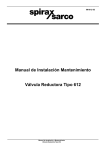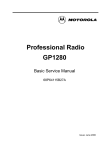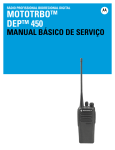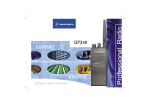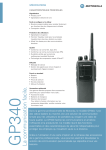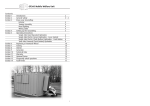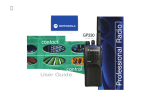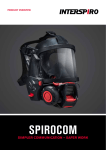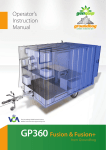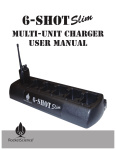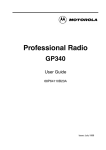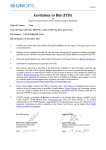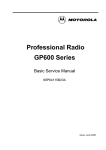Download GP300 Basic Service Manual
Transcript
Professional Radio GP300 Series Basic Service Manual 6864115B18-D Issue: September 2007 ii Computer Software Copyrights The Motorola products described in this manual may include copyrighted Motorola computer programs stored in semiconductor memories or other media. Laws in the United States and other countries preserve for Motorola certain exclusive rights for copyrighted computer programs, including the exclusive right to copy or reproduce in any form, the copyrighted computer program. Accordingly, any copyrighted Motorola computer programs contained in the Motorola products described in this manual may not be copied or reproduced in any manner without the express written permission of Motorola. Furthermore, the purchase of Motorola products shall not be deemed to grant, either directly or by implication, estoppel or otherwise, any license under the copyrights, patents or patent applications of Motorola, except for the normal non-exclusive royalty-free license to use that arises by operation of law in the sale of a product. iii SAFETY INFORMATION Read this information before using the radio. PRODUCT SAFETY AND RF EXPOSURE FOR PORTABLE TWO-WAY RADIOS. This document provides information and instructions for the safe and efficient operation of Motorola Portable Two-Way Radios. RF Energy Exposure Awareness and Control Information and Operational Instructions for Occupational Use Note:This Radio is intended for use in occupational/controlled applications, where users have been made aware of the potential for exposure and can exercise control over their exposure. This radio device is NOT authorized for general population, consumer or similar use. This two-way radio uses electromagnetic energy in the radio frequency (RF) spectrum to provide communications between two or more users over a distance. It uses radio frequency (RF) energy or radio waves to send and receive calls. RF energy is one form of electromagnetic energy. Other forms include, but are not limited to, sunlight and x-rays. RF energy, however, should not be confused with these other forms of electromagnetic energy, which when used improperly, can cause biological damage. Very high levels of x-rays, for example, can damage tissues and genetic material. Experts in science, engineering, medicine, health, and industry work with organizations to develop standards for safe exposure to RF energy. These standards provide recommended levels of RF exposure for both workers and the general public. These recommended RF exposure levels include substantial margins of protection. All Motorola two-way radios are designed, manufactured, and tested to ensure they meet government-established RF exposure levels. In addition, manufacturers also recommend specific operating instructions to users of two-way radios. These instructions are important because they inform users about RF energy exposure and provide simple procedures on how to control it. Please refer to the following websites for more information on what RF energy exposure is and how to control your exposure to assure compliance with established RF exposure limits: http://www.fcc.gov/oet/rfsafety/rf-faqs.html http://www.osha.gov/SLTC/radiofrequencyradiation/index.html Federal Communication Commission (FCC) Regulations (US markets only) The FCC rules require manufacturers to comply with the FCC RF energy exposure limits for portable two-way radios before they can be marketed in the U.S. When two-way radios are used as a consequence of employment, the FCC requires users to be fully aware of and able to control their exposure to meet occupational requirements. Exposure awareness can be facilitated by the use of a product label directing users to specific user awareness information. Your Motorola two-way radio has a RF Exposure Product Label. Do not remove this RF Exposure Label from the device. Also, your Motorola user manual, or separate safety booklet includes information and operating instructions required to control your RF exposure and to satisfy compliance requirements. iv Compliance with RF Exposure Standards Your Motorola two-way radio is designed and tested to comply with a number of national and International standards and guidelines (listed below) for human exposure to radio frequency electromagnetic energy. This radio complies with the IEEE (FCC) and ICNIRP exposure limits for occupational/controlled RF exposure environments at operating duty factors of up to 50% talk50% listen and is authorized by the IEEE/ICNIRP for occupational use only. In terms of measuring RF energy for compliance with these exposure guidelines, your radio generates measurable RF energy only while it is transmitting (during talking), not when it is receiving (listening) or in standby mode. Note: The approved batteries, supplied with this radio, are rated for a 5-5-90 duty cycle (5% talk–5% listen–90% standby), even though this radio complies with IEEE/ICNIRP occupational exposure limits at usage factors of up to 50% talk. Your Motorola two-way radio complies with the following RF energy exposure standards and guidelines: ● ● ● ● ● ● ● United States Federal Communications Commission, Code of Federal Regulations; 47 CFR part 2 sub-part J American National Standards Institute (ANSI) / Institute of Electrical and Electronic Engineers (IEEE) C95. 1-1992 Institute of Electrical and Electronic Engineers (IEEE) C95.1-1999 Edition International Commission on Non-Ionizing Radiation Protection (ICNIRP) 1998 Ministry of Health (Canada) Safety Code 6. Limits of Human Exposure to Radiofrequency Electromagnetic Fields in the Frequency Range from 3 kHz to 300 GHz, 1999 Australian Communications Authority Radiocommunications (Electromagnetic Radiation - Human Exposure) Standard 2003 ANATEL ANNEX to Resolution No. 303 of July 2, 2002 "Regulation of limitation of exposure to electrical, magnetic and electromagnetic fields in the radio frequency range between 9 KHz and 300 GHz" and "Attachment to resolution # 303 from July 2, 2002" RF Exposure Compliance and Control Guidelines and Operating Instructions To control your exposure and ensure compliance with the occupational/controlled environment exposure limits, always adhere to the following procedures: Guidelines: ● ● User awareness instructions should accompany device when transferred to other users. Do not use this device if the operational requirements described herein are not met. Operating Instructions ● ● ● Transmit no more than the rated duty factor of 50% of the time. To transmit (talk), push the Push-ToTalk (PTT) button. To receive calls, release the PTT button. Transmitting 50% of the time, or less, is important because this radio generates measurable RF energy exposure only when transmitting (in terms of measuring for standards compliance). When worn on the body, always place the radio in a Motorola-approved clip, holder, holster, case, or body harness for this product. Using approved body-worn accessories is important because the use of non-Motorola-approved accessories may result in exposure levels, which exceed the IEEE/ ICNIRP occupational/controlled environment RF exposure limits. If you are not using a body-worn accessory and are not using the radio in the intended use position, along side the head in the phone mode (TETRA only), in front of the face in the hand held mode, then ensure the antenna and the radio are kept 2.5 cm (one inch) from the body when transmitting. Keeping the radio at a proper distance is important because RF exposures decrease with increasing distance from the antenna. v Hand-held Mode - Operating Instructions ● Hold the radio in a vertical position in front of the face with the microphone (and other parts of the radio including the antenna) at least 2.5 cm (one inch) away from the nose or lips. Antenna should be kept away from the eye. Keeping the radio at a proper distance is important since RF exposures decrease with increasing distance from the antenna. Phone Mode (TETRA only) - Operating Instructions ● When placing or receiving a phone call, hold your radio product as you would a wireless telephone. Speak directly into the microphone. Approved Accessories ● Use only Motorola-approved supplied or replacement antennas, batteries, and accessories. Use of non– Motorola - approved antennas, batteries and accessories may exceed IEEE/ICNIRP RF exposure guidelines. For a list of Motorola-approved antennas, batteries, and other accessories please see your dealer or local Motorola contact. Your nearest dealer can be found at the following web site: http://www.motorola.com/cgiss/emea/dealerlocator.html Additional Information For additional information on exposure requirements or other training information, visit http://www.motorola.com/rfhealth. vi ELECTROMAGNETIC INTERFERENCE/COMPATIBILITY NOTE: Nearly every electronic device is susceptible to electromagnetic interference (EMI) if inadequately shielded, designed or otherwise configured for electromagnetic compatibility. Facilities To avoid electromagnetic interference and/or compatibility conflicts, turn off your radio in any facility where posted notices instruct you to do so. Hospitals or health care facilities may be using equipment that is sensitive to external RF energy. Aircraft When instructed to do so, turn off your radio when on board an aircraft. Any use of a radio must be in accordance with applicable regulations per airline crew instructions. Medical Devices Pacemakers The Advanced Medical Technology Association (AdvaMed) recommends that a minimum separation of 15 cms (6 inches) be maintained between a handheld wireless radio and a pacemaker.These recommendations are consistent with those of the U.S. Food and Drug Administration. Persons with pacemakers should: ● ● ● ● ALWAYS keep the radio more than 15 cms from their pacemaker when the radio is turned ON. Not carry the radio in the breast pocket. Use the ear opposite the pacemaker to minimize the potential for interference. Turn the radio OFF immediately if you have any reason to suspect that interference is taking place. Hearing Aids Some digital wireless radios may interfere with some hearing aids. In the event of such interference, you may want to consult your hearing aid manufacturer to discuss alternatives. Other Medical Devices If you use any other personal medical device, consult the manufacturer of your device to determine if it is adequately shielded from RF energy. Your physician may be able to assist you in obtaining this information. Use of Communication Devices While Driving Always check the laws and regulations on the use of radios in the areas where you drive. ● ● ● Give full attention to driving and to the road. Use hands-free operation, if available. Pull off the road and park before making or answering a call, if driving conditions or regulations so require. vii OPERATIONAL WARNINGS Vehicles with an air bag Refer to vehicle manufacturer's manual prior to installation of electronic equipment to avoid interference with air bag wiring. ! WARNING: Do not place a portable radio in the area over an air bag or in the air bag deployment area. Air bags inflate with great force. If a portable radio is placed in the air bag deployment area and the air bag inflates, the radio may be propelled with great force and cause serious injury to occupants of the vehicle. Potentially explosive atmospheres ! WARNING: Turn off your radio prior to entering any area with a potentially explosive atmosphere, unless it is a radio type especially qualified for use in such areas as "Intrinsically Safe" (for example, Factory Mutual, CSA, UL, CENELEC or ATEX Approved). Do not remove, install, or charge batteries in such areas. Sparks in a potentially explosive atmosphere can cause an explosion or fire resulting in bodily injury or even death. NOTE The areas with potentially explosive atmospheres referred to above include fuelling areas such as below decks on boats, fuel or chemical transfer or storage facilities, areas where the air contains chemicals or particles, such as grain, dust or metal powders. Areas with potentially explosive atmospheres are often but not always posted. Blasting caps and areas ! WARNING: To avoid possible interference with blasting operations, turn off your radio when you are near electrical blasting caps, in a blasting area, or in areas posted: "Turn off two-way radio". Obey all signs and instructions. OPERATIONAL CAUTIONS Antennas ! CAUTION: Do not use any portable radio that has a damaged antenna. If a damaged antenna comes into contact with your skin, a minor burn can result. Batteries ! CAUTION: All batteries can cause property damage and/or bodily injury such as burns if a conductive material such as jewellery, keys, or beaded chains touch exposed terminals. The conductive material may complete an electrical circuit (short circuit) and become quite hot. Exercise care in handling any charged battery, particularly when placing it inside a pocket, purse, or other container with metal objects. viii INTRINSICALLY SAFE RADIO INFORMATION The Intrinsically safe approval unit refers to a product that has been approved as intrinsically safe by an approval agency (for example FM Approvals, CSA, UL, CENELEC or ATEX) and certifies that a particular product meets the Agency's applicable intrinsic safety standards for specific types of hazardous classified locations. A portable radio that has been approved for intrinsic safety will have Approval label attached to the radio to identify the unit as being Approved for specified hazardous atmospheres. This label specifies the hazardous Class/Division/Group along with the part number of the battery that must be used. The Intrinsically Safe Approval Label will be located on the portable radio unit. Operational Cautions for Intrinsic Safe Equipment ! ● ● ● Do not operate radio communications equipment in a hazardous atmosphere unless it is a type especially qualified (for example, FM, UL, CSA, or CENELEC or ATEX approved). An explosion or fire may result. Do not operate a radio unit that has been approved as intrinsically safe product in a hazardous atmosphere if it has been physically damaged (for example, cracked housing). An explosion or fire may result. Do not replace or charge batteries in a hazardous atmosphere. Contact sparking may occur while installing or removing batteries and cause an explosion or fire. Warnings for Radios Approved as Intrinsically Safe Radios must ship from the Motorola manufacturing facility with the hazardous atmosphere capability and the intrinsic safety approval labelling (FM, UL, CSA, CENELEC or ATEX). Radios will not be upgraded to this capability and labeled once they have been shipped to the field. A modification changes the unit’s hardware from its original design configuration. Modifications can only be made by the original product manufacturer. ! ● ● ● ● ● ● ● Do not replace or changeaccessories in a hazardous atmosphere. Contact sparking may occur while installing or removing accessories and cause an explosion or fire. Turn the radio off before removing or installing a battery or accessory. Do not disassemble an intrinsically safe product in any way that exposes the internal circuits of the unit. Failure to use an intrinsically safe approved battery or Approved accessories specifically approved for the radio unit may result in the dangerously unsafe condition of an unapproved radio combination being used in a hazardous location. Unauthorized or incorrect modification of the intrinsically safe approved Product will negate the approval rating of the product. Incorrect repair or relabeling of any intrinsically safe Agency-approved radio could adversely affect the Approval rating of the unit. Use of a radio that is not intrinsically safe in a hazardous atmosphere could result in serious injury or death. ix Repair ! REPAIRS FOR MOTOROLA PRODUCTS WITH INTRINSICALLY SAFE APPROVAL ARE THE RESPONSIBILITY OF THE USER. ● ● Repairs to a Motorola FM approved radio product should only be done at a location that has been FM audited under the FM 3605 repairs and service standard. Contact Motorola for assistance regarding repairs and service of Motorola intrinsically safe equipment. A repair constitutes something done internally to the unit that would bring it back to its original condition. Items not considered as repairs are those in which an action is performed on a unit which does not require the outer casing of the unit to be opened in a manner which exposes the internal electrical circuits of the unit. Do Not Substitute Options or Accessories The Motorola communications equipment certified as intrinsically safe by the approving agency, (FM, UL, CSA, CENELEC or ATEX) is tested as a complete system which consists of the listed agency Approved portable, Approved battery, and Approved accessories or options, or both. This Approved portable and battery combination must be strictly observed. There must be no substitution of items, even if the substitute has been previously Approved with a different Motorola communications equipment unit. Approved configurations are listed by the Approving Agency (FM, UL, CSA, CENELEC or ATEX). The Intrinsically Safe Approval Label affixed to radio refers to the intrinsically safe classification of that radio product, and the approved batteries that can be used with that system. The manual PN referenced on the Intrinsically Safe Approval Label identifies the approved Accessories and or options that can be used with that portable radio unit. Using a non Motorola intrinsically safe battery and or accessory with the Motorola approved radio unit will void the intrinsically safe approval of that radio unit. x THIS PAGE INTENTIONALLY LEFT BLANK xi Table of Contents Chapter 1 INTRODUCTION 1.0 Scope of Manual.................................................................................................. 1-1 2.0 Warranty and Service Support ............................................................................ 1-1 2.1 Warranty Period and Return Instructions ....................................................... 1-1 2.2 After Warranty Period..................................................................................... 1-1 2.3 European Radio Support Centre (ERSC) ...................................................... 1-2 2.4 Piece Parts..................................................................................................... 1-2 2.5 Technical Support .......................................................................................... 1-3 3.0 Radio Model Information ..................................................................................... 1-4 Chapter 2 INTRINSICALLY SAFE RADIO INFORMATION 1.0 FMRC Approved Equipment................................................................................ 2-1 2.0 Repair of FMRC Approved Products ................................................................... 2-2 2.1 Repair............................................................................................................. 2-2 2.2 Relabelling ..................................................................................................... 2-2 2.3 Do Not Substitute Options or Accessories ..................................................... 2-3 Chapter 3 MAINTENANCE 1.0 Introduction.......................................................................................................... 3-1 2.0 Preventive Maintenance ...................................................................................... 3-1 2.1 Inspection....................................................................................................... 3-1 2.2 Cleaning Procedures...................................................................................... 3-1 3.0 Safe Handling of CMOS and LDMOS Devices.................................................... 3-2 4.0 Repair Procedures and Techniques — General.................................................. 3-3 5.0 Disassembling and Reassembling the Radio — General.................................... 3-3 6.0 Radio Disassembly — Detailed ........................................................................... 3-4 6.1 Front Cover from Chassis Disassembly ......................................................... 3-4 6.2 Chassis Assembly Disassembly .................................................................... 3-7 6.3 Keypad, Display, and Keypad/Option Board Disassembly ............................ 3-8 6.4 Speaker, Microphone, and Universal Connector Flex Disassembly .............. 3-9 6.5 PTT Disassembly ......................................................................................... 3-10 6.6 Control Top Disassembly ............................................................................. 3-11 7.0 Radio Reassembly — Detailed.......................................................................... 3-11 7.1 Control Top Reassembly.............................................................................. 3-11 7.2 PTT Reassembly.......................................................................................... 3-11 7.3 Speaker, Microphone, and Universal Connector Flex Reassembly ............. 3-11 7.4 Keypad, Display, and Keypad Option Board Reassembly ........................... 3-11 7.5 Chassis Assembly Reassembly ................................................................... 3-12 7.6 Chassis and Front Cover Reassembly......................................................... 3-13 xii 8.0 Option Board Installation....................................................................................3-14 8.1 Configuring the Voice Storage Option Board................................................3-15 9.0 Mechanical Views and Parts Lists......................................................................3-17 9.1 GP320/GP340 ..............................................................................................3-17 9.2 GP360/GP380 ..............................................................................................3-19 9.3 GP330...........................................................................................................3-21 10.0 Service Aids .......................................................................................................3-23 11.0 Test Equipment ..................................................................................................3-24 12.0 Programming/Test Cable ...................................................................................3-25 Chapter 4 PERFORMANCE TESTING 1.0 Introduction ..........................................................................................................4-1 2.0 Receiver Performance Tests................................................................................4-1 3.0 Transmitter Performance Tests............................................................................4-2 Chapter 5 RADIO TUNING AND PROGRAMMING 1.0 Introduction ..........................................................................................................5-1 2.0 Global Radio Tuning Setup ..................................................................................5-1 2.1 Initial Test Equipment Setup...........................................................................5-2 3.0 CPS Programming Setup.....................................................................................5-2 Chapter 6 1.0 2.0 3.0 4.0 5.0 MODEL CHART AND TEST SPECIFICATION Model Chart (UHF)...............................................................................................6-1 Model Chart (VHF) ...............................................................................................6-2 Model Chart (LB)..................................................................................................6-3 Model Chart (300R1)............................................................................................6-4 Specifications - Professional GP300 Series Radios ............................................6-5 5.1 GP320/330/340/360/380.................................................................................6-5 Chapter 7 POWER UP SELF-TEST 1.0 Error Codes..........................................................................................................7-1 Chapter 1 INTRODUCTION 1.0 Scope of Manual This manual is intended for use by service technicians familiar with similar types of equipment. It contains service information required for the equipment described and is current as of the printing date. Changes which occur after the printing date may be incorporated by a complete Manual revision or alternatively as additions. NOTE Before operating or testing these units, please read the Safety Information Section in the front of this manual. 2.0 Warranty and Service Support Motorola offers long term support for its products. This support includes full exchange and/or repair of the product during the warranty period, and service/ repair or spare parts support out of warranty. Any "return for exchange" or "return for repair" by an authorised Motorola Dealer must be accompanied by a Warranty Claim Form. Warranty Claim Forms are obtained by contacting an Authorised Motorola Dealer. 2.1 Warranty Period and Return Instructions The terms and conditions of warranty are defined fully in the Motorola Dealer or Distributor or Reseller contract. These conditions may change from time to time and the following notes are for guidance purposes only. In instances where the product is covered under a "return for replacement" or "return for repair" warranty, a check of the product should be performed prior to shipping the unit back to Motorola. This is to ensure that the product has been correctly programmed or has not been subjected to damage outside the terms of the warranty. Prior to shipping any radio back to the appropriate Motorola warranty depot, please contact Customer Resources (Please see page 2 and page 3 in this Chapter). All returns must be accompanied by a Warranty Claim Form, available from your Customer Services representative. Products should be shipped back in the original packaging, or correctly packaged to ensure no damage occurs in transit. 2.2 After Warranty Period After the Warranty period, Motorola continues to support its products in two ways. 1. Motorola's Radio Aftermarket and Accessory Division (AAD) offers a repair service to both end users and dealers at competitive prices. 2. AAD supplies individual parts and modules that can be purchased by dealers who are technically capable of performing fault analysis and repair. 1-2 2.3 INTRODUCTION European Radio Support Centre (ERSC) The ERSC Customer Information Desk is available through the following service numbers: Austria: 06 60 75 41 Italy: 16 78 77 387 Belgium: 08 00 72 471 Luxemburg: 08 00 23 27 Denmark: 80 01 55 72 Netherlands: 60 22 45 13 Finland: 08 00 11 49 10 Norway: 80 01 11 15 France: 05 90 30 90 Portugal: 05 05 49 35 70 Germany: 08 00 18 75 240 Spain: 90 09 84 902 Greece: 00 80 04 91 29 020 Sweden: 02 07 94 307 UK: 08 00 96 90 95 Switzerland: 1 55 30 82 Ireland: 18 00 55 50 21 Iceland: 80 08 147 Or dial Customer Care Centre: Tel: +49 6128 70 2618 Please use these numbers for repair enquiries only 2.4 Piece Parts Some replacement parts, spare parts, and/or product information can be ordered directly. If a complete Motorola part number is assigned to the part, it is available from Motorola Radio Aftermarket and Accessory Division (AAD). If no part number is assigned, the part is not normally available from Motorola. If the part number is appended with an asterisk, the part is serviceable by Motorola Depot only. If a parts list is not included, this generally means that no user-serviceable parts are available for that kit or assembly. All enquiries should be directed to: Motorola GmbH European Parts Department 65232 Taunusstein Germany. Warranty and Service Support 2.5 1-3 Technical Support Motorola Product Services is available to assist the dealer/distributors in resolving any malfunctions which may be encountered. North Europe - Stephen Woodrow Telephone: +44 (0) 1256 488 082 Fax: +44 01256 488 080 Email: [email protected] Central and East Europe - Siggy Punzenberger Telephone: +49 (0) 6128 70 2342 Fax: +49 (0) 6128 95 1096 Email: [email protected] Russia and Belarus - Oleg Machnev Telephone: +7 495 785 0150 Fax: +7 495 785 0185 Email: [email protected] Germany - Customer Connect Team Telephone: +49 (0) 30 6686 1539 Fax: +49 (0) 30 6686 1916 Email: [email protected] Middle East and Africa - Wayne Holmes Telephone: +27 11 800 7922 Fax: +27 11 800 7923 Email: [email protected] Italy - Ugo Gentile Telephone: +39 0 2822 0325 Fax: +39 0 2822 0334 Email: [email protected] France - Armand Roy Telephone: +33 1 6935 7868 Fax: +33 1 6935 7808 Email: [email protected] France - Laurent Irrmann Telephone: +33 1 6935 7866 Fax: +33 1 6935 7808 Email: [email protected] NOTE Only Motorola Service Centers or Approved Motorola Service Dealers can perform these functions. Any tampering by non-authorised Motorola Service Centers voids the warranty of your radio. To find out more about Motorola and its approved Service Centers, please visit http://www.motorola.com/governmentandenterprise/public/functions/home/home.aspx 1-4 3.0 INTRODUCTION Radio Model Information The model number and serial number are located on a label attached to the back of your radio. You can determine the RF output power, frequency band, protocols, and physical packages. The example below shows one portable radio model number and its specific characteristics. Table 1-1 Radio Model Number (Example: MDH25KDC9AA3AE) MD H MD = Motorola Internal Use H = Portable Type of Model Unit Series 25 Freq. Band Power Level Physical Packages Channel Spacing Protocol K VHF (136174MHz) D 3-5W C GP140, GP320, GP330, GP240, GP340, GP540. GP640. 9 Programmable AA Conventional MDC R UHF 1 (403470MHz) S UHF 2 (450527MHz) Feature Level O GP320 2 GP330 E 5-6W H GP280, GP380, GP580, GP680 6 AN Non Conventional Programm 5 Tone able 3 GP140, GP240 GP340, GP540 GP640. T C UHF 1 NB 2-2.5W (450470MHz) N GP1280 CK MPT 5 GP360 B LB1 29-42MHz F GP360 PW MPT/5T 6 GP280 GP380, GP580 GP680 C LB2 35-50MHz FB Privacy Plus 8 GP1280 E 300R1 (300350MHz) FC SmartZone U 800 MHz (806870MHz) Model Model Revision Package A E Chapter 2 INTRINSICALLY SAFE RADIO INFORMATION 1.0 FMRC Approved Equipment Anyone intending to use a radio in a location where hazardous concentrations of flammable material exist (hazardous atmosphere) is advised to become familiar with the subject of intrinsic safety and with the National Electric Code NFPA 70 (National Fire Protection Association) Article 500 (hazardous [classified] locations). An Approval Guide, issued by Factory Mutual Research Corporation (FMRC), lists manufacturers and the products approved by FMRC for use in such locations. FMRC has also issued a voluntary approval standard for repair service (“Class Number 3605”). FMRC Approval labels are attached to the radio to identify the unit as being FM Approved for specified hazardous atmospheres. This label specifies the hazardous FM Class/Division/Group along with the part number of the battery that must be used. APPROVED Depending on the design of the portable unit, this FM label can be found on the back of the radio housing or the bottom of the radio housing.Their Approval mark is shown above. ! WARNING: Do not operate radio communications equipment in a hazardous atmosphere unless it is a type especially qualified (e.g. FMRC Approved) for such use. An explosion or fire may result. WARNING: Do not operate the FMRC Approved Product in a hazardous atmosphere if it has been physically damaged (e.g. cracked housing). An explosion or fire may result. WARNING: Do not replace or charge batteries in a hazardous atmosphere. Contact sparking may occur while installing or removing batteries and cause an explosion or fire. WARNING: Do not replace or change accessories in a hazardous atmosphere. Contact sparking may occur while installing or removing accessories and cause an explosion or fire. WARNING: Do not operate the FMRC Approved Product unit in a hazardous location with the accessory contacts exposed. Keep the connector cover in place when accessories are not used. WARNING: Turn radio off before removing or installing a battery or accessory. WARNING: Do not disassemble the FMRC Approved Product unit in any way that exposes the internal electrical circuits of the unit. Radios must ship from the Motorola manufacturing facility with the hazardous atmosphere capability and FM Approval labeling. Radios will not be “upgraded” to this capability and labeled in the field. A modification changes the unit’s hardware from its original design configuration. Modifications can only be done by the original product manufacturer at one of its FMRC audited manufacturing facilities. ! WARNING: Failure to use an FMRC Approved Product unit with an FMRC Approved battery or FMRC Approved accessories specifically approved for that product may result in the dangerously unsafe condition of an unapproved radio combination being used in a hazardous location. Unauthorized or incorrect modification of an FMRC Approved Product unit will negate the Approval rating of the product. 2-2 INTRINSICALLY SAFE RADIO INFORMATION 2.0 Repair of FMRC Approved Products REPAIRS FOR MOTOROLA FMRC APPROVED PRODUCTS ARE THE RESPONSIBILITY OF THE USER You should not repair or relabel any Motorola manufactured communication equipment bearing the FMRC Approval label (“FMRC Approved Product”) unless you are familiar with the current FMRC Approval standard for repairs and service (“Class Number 3605”). You may want to consider using a repair facility that operates under 3605 repair service approval. ! WARNING: Incorrect repair or relabelling of any FMRC Approved Product unit could adversely affect the Approval rating of the unit. WARNING: Use of a radio that is not intrinsically safe in a hazardous atmosphere could result in serious injury or death. FMRC’s Approval Standard Class Number 3605 is subject to change at any time without notice to you, so you may want to obtain a current copy of 3605 from FMRC. Per the December, 1994 publication of 3605, some key definitions and service requirements are as follows: 2.1 Repair A repair constitutes something done internally to the unit that would bring it back to its original condition Approved by FMRC. A repair should be done in an FMRC Approved facility. Items not considered as repairs are those in which an action is performed on a unit which does not require the outer casing of the unit to be opened in a manner which exposes the internal electrical circuits of the unit. You do not have to be an FMRC Approved Repair Facility to perform these actions. 2.2 Relabelling The repair facility shall have a method by which the replacement of FMRC Approval labels are controlled to ensure that any relabelling is limited to units that were originally shipped from the Manufacturer with an FM Approval label in place. FMRC Approval labels shall not be stocked by the repair facility. An FMRC Approval label shall be ordered from the original manufacturer as needed to repair a specific unit. Replacement labels may be obtained and applied by the repair facility providing satisfactory evidence that the unit being relabelled was originally an FMRC Approved unit. Verification may include, but is not limited to: a unit with a damaged Approval label, a unit with a defective housing displaying an Approval label, or a customer invoice indicating the serial number of the unit and purchase of an FMRC Approved model. Repair of FMRC Approved Products 2.3 2-3 Do Not Substitute Options or Accessories The Motorola communications equipment certified by Factory Mutual is tested as a system and consists of the FM Approved portable, FM Approved battery, and FM Approved accessories or options, or both. This Approved portable and battery combination must be strictly observed. There must be no substitution of items, even if the substitute has been previously Approved with a different Motorola communications equipment unit. Approved configurations are listed in the FM Approval guide published by FMRC, or in the product FM Supplement. This FM Supplement is shipped with FM Approved radio and battery combination from the manufacturer. The Approval guide, or the Approval standard Class Number 3605 document for repairs and service, can be ordered directly through Factory Mutual Research Corporation located in Norwood, Massachusetts. 2-4 INTRINSICALLY SAFE RADIO INFORMATION Chapter 3 MAINTENANCE 1.0 Introduction This chapter provides details about the following: ❏ Preventive maintenance (inspection and cleaning) ❏ Safe handling of CMOS and LDMOS devices ❏ Disassembly and reassembly of the radio ❏ Repair procedures and techniques ❥ Installation of Option Boards NOTE The Servicing of your Intrinsically Safe Radios In order to maintain compliance, radios that are FM Approved to intrinsically safe standards MUST be repaired at FM audited service centers. See Paragraph 2.5 (Technical Support) on page 1-3 for more information. 2.0 Preventive Maintenance The radios do not require a scheduled preventive maintenance program; however, periodic visual inspection and cleaning is recommended. 2.1 Inspection Check that the external surfaces of the radio are clean, and that all external controls and switches are functional. It is not recommended to inspect the interior electronic circuitry. 2.2 Cleaning Procedures The following procedures describe the recommended cleaning agents and the methods to be used when cleaning the external and internal surfaces of the radio. External surfaces include the front cover, housing assembly and battery case. These surfaces should be cleaned whenever a periodic visual inspection reveals the presence of smudges, grease, and/or grime. NOTE Internal surfaces should be cleaned only when the radio is disassembled for service or repair. The only recommended agent for cleaning the external radio surfaces is a 0.5% solution of a mild dishwashing detergent in water. The only factory recommended liquid for cleaning the printed circuit boards and their components is isopropyl alcohol (70% by volume). ! CAUTION: The effects of certain chemicals and their vapors can have harmful results on certain plastics. Avoid using aerosol sprays, tuner cleaners, and other chemicals. Cleaning External Plastic Surfaces Apply the 0.5% detergent-water solution sparingly with a stiff, non-metallic, short-bristled brush to work all loose dirt away from the radio. Use a soft, absorbent, lintless cloth or tissue to remove the solution and dry the radio. Make sure that no water remains entrapped near the connectors, cracks, or crevices. 3-2 MAINTENANCE Cleaning Internal Circuit Boards and Components Isopropyl alcohol (70%) may be applied with a stiff, non-metallic, short-bristled brush to dislodge embedded or caked materials located in hard-to-reach areas. The brush stroke should direct the dislodged material out and away from the inside of the radio. Make sure that controls or tunable components are not soaked with alcohol. Do not use high-pressure air to hasten the drying process since this could cause the liquid to collect in unwanted places. After completing of the cleaning process, use a soft, absorbent, lintless cloth to dry the area. Do not brush or apply any isopropyl alcohol to the frame, front cover, or back cover. NOTE Always use a fresh supply of alcohol and a clean container to prevent contamination by dissolved material (from previous usage). 3.0 Safe Handling of CMOS and LDMOS Devices Complementary metal-oxide semiconductor (CMOS) devices are used in this family of radios, and are susceptible to damage by electrostatic or high voltage charges. Damage can be latent, resulting in failures occurring weeks or months later. Therefore, special precautions must be taken to prevent device damage during disassembly, troubleshooting, and repair. Handling precautions are mandatory for CMOS circuits and are especially important in low humidity conditions. DO NOT attempt to disassemble the radio without first referring to the following CAUTION statement. ! CAUTION: This radio contains static-sensitive devices. Do not open the radio unless you are properly grounded. Take the following precautions when working on this unit: ❏ Store and transport all CMOS devices in conductive material so that all exposed leads are shorted together. Do not insert CMOS devices into conventional plastic “snow” trays used for storage and transportation of other semiconductor devices. ❏ Ground the working surface of the service bench to protect the CMOS device. We recommend using the Motorola Static Protection Assembly (part number 0180386A82), which includes a wrist strap, two ground cords, a table mat, and a floor mat. ❏ Wear a conductive wrist strap in series with a 100k resistor to ground. (Replacement wrist straps that connect to the bench top covering are Motorola part number RSX4015.) ❏ Do not wear nylon clothing while handling CMOS devices. ❏ Do not insert or remove CMOS devices with power applied. Check all power supplies used for testing CMOS devices to be certain that there are no voltage transients present. ❏ When straightening CMOS pins, provide ground straps for the apparatus used. ❏ When soldering, use a grounded soldering iron. ❏ If at all possible, handle CMOS devices by the package and not by the leads. Prior to touching the unit, touch an electrical ground to remove any static charge that you may have accumulated. The package and substrate may be electrically common. If so, the reaction of a discharge to the case would cause the same damage as touching the leads. Repair Procedures and Techniques — General 4.0 3-3 Repair Procedures and Techniques — General NOTE Environmentally Preferred Products (EPP) (refer to the marking on the printed circuit boards) were developed and assembled using environmentally preferred components and solder assembly techniques to comply with the European Union’s ROHS and WEEE directives (Waste Electrical and Electronic Equipment (WEEE) Directive 2002/96/EC and Restriction of Hazardous Subtances (ROHS) Directive 2002/95/EC). To maintain product compliance and reliability, use only the Motorola specified parts in this manual. For the identification of lead (Pb) free assemblies, all EPP products will carry the EPP Marking, shown below, on the printed circuit board (PCB). This marking provides information to those performing assembly, servicing and recycling operation on this product, adhering to the JEDEC standard #97. The EPP Marking takes the form of a label or marking on the PCB. Parts Replacement and Substitution When damaged parts are replaced, identical parts should be used. If the identical replacement part is not locally available, check the parts list for the proper Motorola part number and order the part from the nearest Motorola Communications parts centre listed in the “Piece Parts” section of this manual. Rigid Circuit Boards This family of radios uses bonded, multi-layer, printed circuit boards. Since the inner layers are not accessible, some special considerations are required when soldering and unsoldering components. The printed-through holes may interconnect multiple layers of the printed circuit. Therefore, exercise care to avoid pulling the plated circuit out of the hole. When soldering near the 20-pin and 40-pin connectors: ❏ Avoid accidentally getting solder in the connector. ❏ Be careful not to form solder bridges between the connector pins. ❏ Examine your work closely for shorts due to solder bridges. Flexible Circuits The flexible circuits are made from a different material than the rigid boards, and require different soldering techniques. Excessive prolonged heat on a flexible circuit can damage the material. Therefore, avoid excessive heat and excessive bending. For parts replacement, use the ST-1087 Temperature-Controlled Solder Station with a 600-700 degree tip, and use small diameter solder such as ST-633. The smaller size solder will melt faster and require less heat to be applied to the circuit. To replace a component on a flexible circuit: 1. Grasp with seizers (hemostats) the edge of the flexible circuit near the part to be removed. 3-4 MAINTENANCE 2. Pull gently. 3. Apply the tip of the soldering iron to the component connections while pulling with the seizers. NOTE Do not attempt to puddle-out components. Prolonged application of heat may damage the flexible circuit. 5.0 Disassembling and Reassembling the Radio — General Since these radios may be disassembled and reassembled with the use of only four (board to casting) screws, it is important to pay particular attention to the snaps and tabs, and how parts align with each other. The following tools are required for disassembling the radio: ❏ Small flat blade screwdriver ❏ penknife-size screwdriver ❏ TORX™ T6 screwdriver ❏ Chassis opener (6680702Z01) If a unit requires more complete testing or service than is customarily performed at the basic level, send this unit to a Motorola Authorized Service Centre. (See Chapter 1 for a list of authorized service centres.) The following disassembly procedures should be performed only if necessary: Chassis Assembly Disassembly (Paragraph 6.2) Keypad, Display, and Keypad/Option Board Disassembly (Paragraph 6.3) Speaker, Microphone, and Universal Connector Flex Disassembly (Paragraph 6.4) PTT Disassembly (Paragraph 6.5) Control Top Disassembly (Paragraph 6.7) 6.0 Radio Disassembly — Detailed 6.1 Front Cover from Chassis Disassembly 1. Turn off the radio. 2. Remove the battery: a. Pull down on the two battery-release buttons. b. With the buttons pulled down, the top of the battery will fall from the radio. Radio Disassembly — Detailed c. 3-5 Remove the battery from the radio. Battery Release Buttons Figure 3-1 Battery Removal 3. Remove the antenna. 4. Pull the volume and channel selector knobs off of their shafts. Knobs Figure 3-2 Knob Removal NOTE Both knobs slide on and off. However, they are supposed to fit very tightly on their shafts. 5. Separate the chassis from the internal electronics front cover assembly as follows: a. Insert a small, flat-blade screwdriver, or similar instrument, in between the thin retaining wall and the chassis at the bottom of the radio. Do not mar the O-ring sealing area on the housing. 3-6 MAINTENANCE b. Slowly pry the bottom of the chassis from the cover by pushing the small flat-blade screwdriver down, or chassis opener (6680702Z01) and rotating the handle of the tool over and behind the base of the radio. This prying action forces the thin inner plastic wall toward the base of the radio, releasing the two chassis base tabs. Radio Chassis Figure 3-3 Chassis Removal ! CAUTION: Marring the front cover O-ring sealing area will prevent the radio from sealing properly. NOTE Flexible ribbon circuits (flexes) connecting the front cover assembly and the chassis prevent you from completely separating the two units. Display radios and radios with option boards have two flexes. 6. Lay the chassis down. Rotate the front cover backward and slightly away from the chassis. 7. Lift the latches on the main circuit board to release the flexes from their connectors. Latches Flex Connectors Figure 3-4 Unlatch Flex Connectors Radio Disassembly — Detailed 6.2 3-7 Chassis Assembly Disassembly 1. Use a TORX™ screwdriver with a T6 head to remove the four screws holding the main board to the chassis. Compliant Ground Contact Main Board Radio Chassis O-ring Retaining Features Figure 3-5 Remove Main Board from Chassis 2. ! Lift the main board from the chassis (See Figure 3-5). CAUTION: Refer to the CMOS CAUTION paragraph on page 2 before removing the main board. Be sure to use ESD protection when handling circuit boards. 3. 4. 5. Remove the four small O-ring retainers from their slots in the chassis. Note the alignment of the retainers for reassembly. Remove the O-ring. Slide off the ground contact from the top corner boss of the radio chassis. 3-8 6.3 MAINTENANCE Keypad, Display, and Keypad/Option Board Disassembly 1. If the disassembly of the keypad, the keypad printed circuit board, or the display is required, lift the microphone flex circuit up, and carefully remove the microphone and its boot from the front cover pocket. (See Figure 3-6.) 2. Lay this flex circuit to one side. 3. To remove the keypad retainer shield: a. Insert the tip of a “penknife size,” flat blade screwdriver in the opening at the end of the keypad retainer arm tab. b. Pry the tab away from the side of the front cover until it moves past the ledges on the side wall. Duplicate this procedure for each of the four retainer arm tabs. Speaker-Microphone Flex Circuit Tail Flat Blade Screwdriver Keypad Retainer Arm Tabs (4) Retainer Top Hooks Retainer GP360/380 Figure 3-6 Remove Retainer ! 4. Note that the two “top hooks” are still held underneath the front cover—right below the speaker. Lift the keypad retainer out of the front cover; then, lift and pivot the two hooks out of the front cover. 5. If disassembly involves the removal of the display module, disconnect the display flex from the keypad option board connector by lifting the latch on the connector. (This is similar to the process for releasing the flexes.) 6. The display module is attached to the front cover with a double-sided adhesive pad. Carefully pull up on the display module, using a small screwdriver, if necessary, and remove it from the front cover. Use a new piece of double-sided adhesive to re-mount the display to the cover. CAUTION: Take care not to damage the display. Do not cut, bend, or pinch the heat seal. Display modules contain CMOS devices. Be sure to use ESD protection. Radio Disassembly — Detailed 7. 3-9 The keypad/option board, and the keypad, can be removed without the use of tools. Retainer 1 Display Module 2 Keypad/Option Board 3 Keypad Radio Body GP360/380 Figure 3-7 Removing the Keypad Retainer and Other Boards from the Radio Body NOTE At this point, the Option Board Installation Procedure should be performed, if necessary. 6.4 Speaker, Microphone, and Universal Connector Flex Disassembly 1. Turn the screw at the bottom of the dustcover counterclockwise with your fingers. Lift the dustcover out of its pocket. NOTE The dustcover must be removed to remove the speaker-microphone assembly flex circuit. The speaker is held in place with a two-legged retainer bracket. The bracket legs are secured by the front cover slots. Be careful not to damage the speaker when removing the retainer bracket. 2. Using a screwdriver, push down on the portion of the speaker retainer bracket pointing toward the bottom of the radio. Then, remove the retainer by slightly pushing it toward the top of the radio until you slide it past the front cover slot. 3. Pull the rubber microphone boot from its seated position. Unless you are replacing the microphone, leave it in the boot. NOTE The speaker-microphone assembly flex circuit goes through the front cover wall to the out- side wall. To replace this assembly, you must peel-off the universal connector escutcheon label. The existing escutcheon cannot be reassembled; a new part must be used. (See item number 10 [GP360/380] on the exploded view drawing.) 4. Peel-off the universal connector flex circuit escutcheon (label). 5. Pry the flex circuit (adhesive held) backer board away from the front cover, and remove the universal connector tail of the speaker-microphone assembly through its opening in the front cover. 3-10 MAINTENANCE Notch In Speaker @ 12:00 Speaker Speaker Orientation Tab @ 12:00 Universal Connector Tail Microphone Boot Microphone Speaker Microphone Flex Circuit Assembly 6. 6.5 Figure 3-8 Removal Speaker-Microphone Assembly After the universal connector tail of the speaker-microphone assembly is removed, the assembly can be completely removed. If it is necessary to replace the speaker or microphone, or both, do it while the flex circuit is removed from the front cover. When reassembling the microphone in its boot, make sure the microphone port faces the round hole in the bottom of the boot. PTT Disassembly 1. If required, the PTT bezel, and the PTT seal assembly, can be disassembled using a small screwdriver, as follows: PTT Bezel “T” Shaped Retainer Pad Tab Tab PTT Seal Figure 3-9 PTT Removal a. Pry back the T-tab found inside the front cover (in between the four buttons on the PTT assembly). b. Remove the PTT bezel by slightly bowing it until the top and bottom tabs are released from the slots in the front cover. c. The PTT seal can be easily lifted from the bezel without the use of tools. Radio Reassembly — Detailed 6.6 Control Top Disassembly 1. To remove the control top assembly, place a screwdriver next to the antenna boss, and pry it against the control top escutcheon. This will lift the control top escutcheon away from its double-sided adhesive. Grasp the double-sided adhesive near the volume potentiometer, and lift it away. 2. Remove the control top seal, emergency button, and transmit light pipe. 7.0 Radio Reassembly — Detailed 7.1 Control Top Reassembly 7.2 3-11 1. Replace transmit light pipe and control top seal. 2. Place a new control top escutcheon adhesive against the front cover. Press the control top escutcheon tightly against the adhesive. 3. Put the PTT seal in the PTT bezel. PTT Reassembly 1. Place the bezel top tab in the top slot inside the front cover PTT opening. Slightly bow the bezel so that the bottom tab can fall inside the bottom slot. 2. Press the PTT assembly against the front cover opening. NOTE Look inside the front cover to make sure the T-tab is fully engaged with the front cover. If necessary, press the T-tab toward the top of the radio until it becomes fully engaged. 7.3 7.4 Speaker, Microphone, and Universal Connector Flex Reassembly 1. Feed the universal connector tail of the speaker-microphone flex assembly through the opening in the side wall of the front cover. 2. Peel-off the adhesive liner on the back of the universal connector tail of the flex circuit. Attach the flex tail to the front cover using the guide pins for correct alignment. 3. Replace the universal connector escutcheon. Make sure that all the connector openings align with the gold pads on the flex circuit. 4. Align the notch in the speaker at the twelve o’clock position with the tab on the front cover. (See Figure 3-8.) 5. Place the speaker retainer bracket into the hole on the top of the front cover, and bend the retainer down to fit underneath the boss below the speaker. Keypad, Display, and Keypad Option Board Reassembly 1. If you are replacing the display, use a new double-sided adhesive display pad (item number 17 [GP360/380] on the exploded view diagram). 2. Replace the keypad, and the keypad/option board. Make sure the display module flex tail is connected correctly to the connector on the keypad/option board. 3. Insert the “top hooks” of the keypad retainer into the slots below the speaker (above the display) in the front cover. Snap all of the retainer arm tabs in place in the front cover. NOTE Pull the speaker-microphone flex circuit out of harm’s way during reassembly. 3-12 MAINTENANCE 4. Re-insert the microphone and boot into the pocket in the front cover. 5. Lay the speaker-microphone flex on top of keypad/option board retainer. Catches Retainer GP360/380 Figure 3-10 Lock retainer catches to the radio’s body 7.5 Chassis Assembly Reassembly 1. Slide on the ground contact (if necessary) on the top corner boss of the chassis. 2. Replace the O-ring. The tabs on the O-ring should reach around the chassis and point down. 3. Stretch the O-ring to place it into the retaining pocket at the bottom end of the chassis. NOTE When properly assembled, the retainers on the O-ring should align with the slots on the chassis. If this is not the case, remove and replace the O-ring until it is aligned with the chassis and completely seated in place around the perimeter. 4. Ensure that the antenna nut insulator is correctly replaced by pushing it all the way to the top of the antenna nut. 5. Replace the battery contact seal (if necessary) surrounding the battery contact. 6. Place the main circuit board straight down on top of the chassis. NOTE Be sure the battery contact seal protrudes through the chassis and is not pinched under the chassis. 7. Use the T6 TORX screwdriver to fasten the screws holding the main board to the chassis. Radio Reassembly — Detailed 7.6 3-13 Chassis and Front Cover Reassembly 1. Align the chassis assembly end-to-end with the front cover assembly. 2. Insert the tails of the flex circuits into their respective connectors at the bottom of the front cover. 3. Push down the latches on the connectors to hold the flex circuits to the main board. 4. Slide the volume potentiometer and frequency switch shafts into their respective holes in the front cover. 5. Push the chassis assembly completely into the top of the front cover until it settles in place. 6. Be sure the O-ring is properly seated. 7. Snap the bottom of the chassis into the front cover. 8. Reassemble the knobs, dust cover, antenna, and battery. Radio Chassis GP320/340/360/380 Figure 3-11 Fastening the Chassis 3-14 Option Board Installation 1. With the keypad retainer removed, the keypad backer board can be removed without the use of tools. 2. Remove the jumper flex from the connector on the keypad board. Notice the orientation of the flex to the connector. Arrows on the jumper flex point to the correct way of inserting the flex into the connector. 3. Discard the keypad backer board. 4. The “breakaway” tab at the top of all option boards contains an extra row of keys and is used to accommodate other radio models. 5. Break-off and discard the option board tab, taking care not to damage the option board. Trim any tab fragments that may remain on the option board. 6. Reassemble the option board to the front cover assembly. Retainer Jumper Flex Keypad/Option Board TO KP 8.0 MAINTENANCE Display Flex Figure 3-12 Changing the Keypad/Option Board 7. Insert the display flex circuit into the connector on the option board. 8. Insert the jumper flex circuit into the connector on the option board. Notice the orientation of the flex circuit. Arrows on the jumper flex point to the correct way of inserting the flex into the connector. 9. Replace the retainer by placing the two top hooks into the slots below the speaker in the front cover; then, pivot the retainer into the front cover. Ensure that all four tab arms snap correctly into the front cover. 10. With the keypad option board, display, and retainer correctly in place, the front cover assembly can now be reassembled as described in Paragraph 7.6 (Chassis and Front Cover Reassembly). Option Board Installation 8.1 3-15 Configuring the Voice Storage Option Board 1. Connect the radio to your computer following the instructions outlined in CPS Programming Setup on page 4.3. 2. Start up the CPS, and read the radio’s codeplug. 3. Choose Miscellaneous from the Per Radio drop-down menu. 4. In the Miscellaneous dialog box, click on the Global and choose Voice Storage from the Option Board Type. 5. Choose Signalling Definition from the Per Radio drop-down menu. In the Signalling Definition dialog box, click on the Voice Storage check box to activate voice storage. 3-16 MAINTENANCE 6. Choose Menu Item from the Per Radio drop-down menu. In the Menu Item dialog box, click on the Voice Storage check box, followed by any other desired Voice Storage related check boxes. 7. Choose Button Definition from the Per Radio drop-down menu. In the Button Definition dialog box, configure your radio’s relevant programmable buttons to activate the desired Voice Storage function. 8. Choose Per Personality from the Per Personality drop-down menu. Click on the Option Board check box. Mechanical Views and Parts Lists 9.0 Mechanical Views and Parts Lists 9.1 GP320/GP340 Figure 3-13 Radio Exploded Mechanical View (GP320/GP340) 3-17 3-18 Item Mechanical Views and Parts Lists Motorola Part Number Description Item Motorola Part Number Description 1 See Chapter 6 Antenna 22 5015027H01 Microphone 2 3680529Z01 Knob, Volume 23 7586477Z01 Poron Pad 3 3680530Z02 Knob, Frequency 24 4 1380525Z01 1380525Z02 Escutcheon, Top - GP340 Escutcheon, Top - GP320 8415169H01 8415169H02* Flex, UC 25 1405307X01 Insulator kapton 5 3385681Z02 Escutcheon, Label 26 4286410Z01 Retainer, Speaker 6 3280533Z05 3280533Z04 Seal, Control Top - GP340 Seal, Control Top - GP320 27 2113944C81* Capacitor. 24pF 28 7 6180527Z01 Litepipe, Tx 2113740A41 2113944F54 Capacitor, 33pF - non EPP Cpacitor 33pF - EPP 8 1364279B02 1364279B03 Front, label - GP320 Front, label - GP340 29 7580671Z01 Pad (Flexible circuit) 30 3916290H01** Contact, Pad, Foam - GP340 9 1586059A01 Dust Cover, Universal Connector 31 7505870Z05** Pad conductive foam - GP340 10 1386058A01 Escutcheon, Universal Flex 32 7580671Z03 Pad (Flexible Flex) - GP320 11 1586335Z03 Front Cover, Basic 33 0304726J05 Screw 1580666Z04 Front Cover with Keypad (DTMF) 34 7586477Z01* Poron Pad - GP340 35 7585734Z01* Pad (VCO Shield) 1580666Z06 Front Cover - GP320 36 See Chapter 6 12 Not Field Replaceable Escutcheon, FM Back Cover Kit incl chassis main board 37 3980667Z04 Contact finger (x3) 13 7580532Z01 7580532Z08 Keypad, Side Control -GP340 Keypad, Side Control -GP320 38 1485673Z01 Insulator, Antenna 14 1386324Z01 1380528Z03 Bezel, Side Control - GP340 Bezel, Side Control - GP320 39 3280534Z02 Seal, Contact 40 7580556Z02 Pad, Thermal 4285672Z01 Retaining clip - GP320 41 3286406Z01 Gasket O-Ring 15 1471531L01 Insulator 42 3980698Z01 Contact, Ground, Compliant, VHF 16 1485924Z01 Insulator board - GP340 43 17 7586481Z01 Pad retainer - GP340 2780518Z06 2771798M01* Chassis 18 4286266Z01 Retainer, Keypad PCB GP340 44 See Chapter 6 Battery 45 HLN9714 Beltclip 19 3586057A03 Felt Speaker 20 1480577C01 Boot, Microphone * For UHF Band 1 only 21 5085738Z10 5085738Z03 Speaker - EPP Speaker - non EPP ** For UHF and VHF Mechanical Views and Parts Lists 9.2 GP360/GP380 Figure 3-14 Radio Exploded Mechanical View (GP360/GP380) 3-19 3-20 Item Mechanical Views and Parts Lists Motorola Part Number Description 1 See Chapter 6 Antenna 2 3680529Z01 Knob, Volume 3 3680530Z02 Knob, Frequency 4 1380525Z03 Escutcheon, Top 5 3385681Z02 Escutcheon, Label 6 3280533Z05 Seal, Control Top 7 6180527Z01 Litepipe, Tx 8 1364279B04 1364279B05 Front, label GP360 Front, label GP380 9 1586059A01 Dust Cover, Universal Connector 10 1386058A01 Escutcheon, Universal Flex 11 1586335Z0111 Front cover, GP360 Front Cover GP380 586335Z02 1580666Z04 Front Cover with Keypad (DTMF) Item 27 Motorola Part Number Description 8415169H01 8415169H02* Flex, UC 28 1405307X01 Insulator kapton 29 2113944C81* Capacitor, 24pF 30 3113944F54 Capacitor, 33pF 31 4286410Z01 Retainer, Speaker 32 1480503Z01 Boot, Backup Battery 33 7580671Z01 Pad (Flexible circuit) 34 3916290H01** Contact, Pad, Foam - GP340 35 7586477Z01* Poron Pad 36 7505870Z05** Pad conductive foam 37 6062884G01 Backup Battery 38 0304726J05 Screw 39 7585734Z01* Pad (VCO Shield) 40 See Chapter 6 Back Cover Kit incl chassis main board 41 8415157H01 Flex, Keypad/Controller 42 3980667Z04 Contact finger (x3) 43 1485673Z01 Insulator, Antenna 44 7580556Z02 Pad Thermal 45 3280534Z02 Seal, Contact 12 Not Field Replaceable Escutcheon, FM 13 7580532Z08 Keypad, Side Control 14 1386324Z01 Bezel, Side Control 15 1471531L01 Insulator 16 7586265Z06 7586265Z05 Keypad - GP360 Keypad - GP380 17 0104007J99 Keypad Board Assembly 46 3286406Z01 Gasket O-Ring 18 7580540Z02 Pad, display 47 3980698Z01 19 5104949J19 LCD module Contact, Ground, Compliant, VHF 20 7580637Z01 Pad, LCD Back 48 2780518Z06 2771798M01* Chassis 21 4286266Z01 Retainer, Keypad PCB 49 See Chapter 6 Battery 22 3586057A03 Felt Speaker 50 HLN9714 Beltclip 23 1480577C01 Boot, Microphone 24 5085738Z10 Speaker 25 5015027H01 Microphone 26 7586477Z01 Poron Pad * For UHF Band 1 only ** For UHF and VHF Mechanical Views and Parts Lists 9.3 GP330 Figure 3-15 Radio Exploded Mechanical View (GP330) 3-21 3-22 Item Mechanical Views and Parts Lists Motorola Part Number Description Item Motorola Part Number Description 1 See Chapter 6 Antenna 29 0304726J05 Screw, Torx T-6 (4X) 2 3680529Z01 Volume Knob 30 0104018J51 RF Board 3 3680530Z02 Frequency Knob 31 1485673Z01 Insulator, Antenna 4 1380525Z06 Top Escutcheon 32 3980667Z04 Contact Finger (x3) 5 3385681Z02 Escutcheon Label 33 7580556Z02 Pad Thermal 6 3280533Z06 Control Top Seal 34 3280534Z02 Battery Contact Seal 7 6180527Z01 Lightpipe 35 3286406Z01 Gasket O-Ring 8 3380660Z12 Front, Label 36 3980698Z01 Contact, ground, VHF 9 1586059A01 Dust Cover, Universal Connector 37 2780518Z06 2771798M01* Chassis 38 See Chapter 6 Battery 39 HLN9714 Beltclip 10 1386058A01 Escutcheon, Universal Connector 11 1380528Z03 Bezel, Side Control 12 7580532Z03 Keypad, Side Control 13 1580666Z06 Cover, Front Assembly 14 4285672Z01 Clip, Bezel 15 3586057A03 Felt, Speaker 16 1471531L01 Insulator 17 1480577C01 Boot, Microphone 18 5085738Z10 Speaker 19 5015027H01 Mini Electret, Microphone 20 2113944F54 Capacitor, 33pF 21 8415169H01 8415169H02* Flex, Universal Connector 22 7586477Z01 Pad, Poron 23 2113944C81* Capacitor, 24pF 24 4286410Z01 Retainer, Speaker 25 1405307X01 Insulator kapton 26 3916290H01 Foam, Conductive 27 7580671Z01 Pad (Flexible circuit) 28 7580671Z03 Pad (Flexible Flex) * For UHF Band 1 only. Service Aids 10.0 3-23 Service Aids Table 3-1 lists service aids recommended for working on the GP300 Series Radios. While all of these items are available from Motorola, most are standard shop equipment items, and any equivalent item capable of the same performance may be substituted for the item listed. Table 3-1 Service Aids Motorola Part No. Description Application RLN4460_ Portable Test Set Enables connection to the audio/accessory jack. Allows switching for radio testing. RKN4075_ Ribless Programming Cable Connects radio to Computer. RKN4074_ Programming Cable/Test Cable Connects radio to RIB (RLN4008_). RLN4008_ Radio Interface Box (RIB) Enables communications between the radio and the computer’s serial communications adapter. HLN9756_ BNC Adaptor Adapts radio’s antenna port to BNC cabling of test equipment. HKN9743_ MAP27 Cable Connects radio to computer for MAP27 applications in MPT requirements. HLN9742_ Flash Upgrade Adapter Provides connections to the computer or RIB programming /test cable 0180305G54 Shop Battery Eliminator Interconnects radio to power supply. 8180384F66 Bench Test Housing Eliminator for long housing. Provides for troubleshooting of the radio when the housing is removed. 8180384F68 Bench Test Housing Eliminator for short housing. Provides for troubleshooting of the radio when the housing is removed. RLN4510 Battery Eliminator 7.5V Interconnects radio to power supply. EPN4040 Wall-Mounted Power Supply Used to supply power to the RIB (UK). EPN4041 Wall-Mounted Power Supply Used to supply power to the RIB (Euro) 3080369B71 or 3080369B72 Computer Interface Cable Use B72 for the IBM PC AT. All other IBM models use B71. Connects the computer’s serial communications adapter to the RIB. (RLN4008_) 3-24 MAINTENANCE 11.0 Test Equipment Table 3-2 lists test equipment required to service the GP300 Series Radios and other two-way radios. Table 3-2 Recommended Test Equipment Motorola Part No. Description Characteristics Application R2600_NT Comms System Analyzer (non MPT) This monitor will substitute for items with an asterisk * Frequency/deviation meter and signal generator for wide-range troubleshooting and alignment R2680_NT to be ordered with RLN1022_ (H/W) RLN1023_ (S/W) Comms System Analyzer (MPT1327) This monitor will substitute for items with an asterisk * Frequency/deviation meter and signal generator for wide-range troubleshooting and alignment *R1072_ Digital Multimeter *R1377_ AC Voltmeter 100 µV to 300 V, 5Hz-1MHz, 10 Megohm input impedance Audio voltage measurements WADN4133_ Delay Oscilloscope 2 Channel 40 MHz bandwidth, 5 mV/cm - 20 V/cm Waveform measurements R1440_ Wattmeter, Transmitter power output measurements 0180305F22 0180305F30 0180305F39 RLN4610_ Plug-in Element Plug-in Element Plug-in Element Carry case Thruline 50-Ohm, ±5% accuracy 10W, 50 - 125 MHz 10W, 100 - 250 MHz 10W, 200 - 500 MHz Wattmeter and 6 elements *T1013_ RF Dummy Load S1339_ RF Millivolt Meter 100mV to 3 VRF, 10 kHz to 1.2 GHz RF level measurements S1348_ 220V Power Supply 0-20V, 5A Programmable AC/DC voltage and current measurements Programming/Test Cable 3-25 12.0 Programming/Test Cable 1 metre Cable 1 metre Cable Side Connector RKN4074_ Figure 3-16 Programming Test/Cable Internal Connections 1 2 3 4 5 6 7 8 9 10 11 12 13 Pin Outs External Speaker + Brown External Speaker - Dark Blue Option B + Red External Mic Grey Option Select 2 Light Blue Option Select 1 Tan Ground Black Receive Data Yellow Transmit Data Pink RSSI Orange Tx Audio / Rx Audio Violet Boot Control Green Not Used White Figure 3-17 Pin Configuration of the Side Connector 1 2 3 4 5 6 7 8 9 10 11 12 13 3-26 MAINTENANCE 25 Pos Male D Connector Side Connector 1 1 5 2 2 7 3 8 4 15 5 20 6 16 7 9 8 9 10 11 18 12 25 13 25 Pos Female D Connector 15 1 4 11 Figure 3-18 Wiring of the Connectors Chapter 4 PERFORMANCE TESTING 1.0 Introduction The receiver and transmitter performance tests are contained in Tables 4-1 and 4-2 respectively. Refer to Chapter 5 for the test equipment set up. Note that all test measurements are taken at 25°C. 2.0 Receiver Performance Tests The receiver performance tests are described in Table 4-1 below. Table 4-1 Receiver Performance Checks Test Name Communications Analyzer Radio Test Set Comments Reference Frequency Mode: PWR MON Monitor: Frequency error Input at RF In/Out TEST MODE, Test Channel 4 carrier squelch output at antenna PTT to continuous (during the performance check) Frequency error to be ±200Hz VHF ±600Hz UHF Rated Audio Mode: GEN Output level: 1.0mV RF Mod: 1kHz tone at 3kHz deviation Monitor: DVM: AC Volts TEST MODE Test Channel 4 carrier squelch PTT to OFF (centre), meter selector to Audio PA Set volume control to 3.16Vrms Distortion As above, except to distortion As above As above Distortion 3.0% Typical Sensitivity (SINAD) As above, except SINAD, lower the RF level for 12dB SINAD. As above PTT to OFF (center) RF input to be 0.25µV Noise Squelch Threshold (only radios with conventional system need to be tested) RF level set to 1mV RF As above PTT to OFF (center), meter selection to Audio PA, spkr/ load to speaker Set volume control to 3.16Vrms As above, except change frequency to a conventional system. Raise RF level from zero until radio unsquelches. Out of TEST MODE; select a conventional system As above Unsquelch to occur at <0.25µV. Preferred SINAD = 9-10dB 4-2 3.0 PERFORMANCE TESTING Transmitter Performance Tests The transmitter performance tests are described in Table 4-2 below. Table 4-2 Transmitter Performance Checks Test Name Communications Analyzer Radio Test Set Comments Reference Frequency Mode: PWR MON Monitor: Frequency error Input at RF In/Out TEST MODE, Test Channel 4 carrier squelch PTT to continuous (during the performance check) Frequency error to be ±200Hz VHF ±600Hz UHF Power RF As above As above As above Refer to Maintenance Specifications Voice Modulation Mode: PWR MON atten to -70, input to RF In/Out Monitor: DVM, AC Volts Set 1kHz Mod Out level for 0.025Vrms at test set, 80mVrms at AC/DC test set jack As above As above, meter selector to mic Deviation: VHF, UHF, ≥ 4.0kHz but ≤ 5.0kHz. (25 kHz Ch Sp) Voice Modulation (internal) Mode: PWR MON atten to -70, input to RF In/Out TEST MODE, Test Channel 4 carrier squelch output at antenna Remove modulation input Press PTT switch on radio. Say “four” loudly into the radio mic. Measure deviation: VHF, UHF, ≥ 4.0kHz but ≤ 5.0kHz (25 kHz Ch Sp) DTMF Modulation As above, TEST MODE, Test Channel 4 DTMF output at antenna As above Deviation: VHF, UHF, ≥ 3.05kHz but ≤ 3.45kHz (25 kHz Ch Sp). PL/DPL Modulation As above BW to narrow TEST MODE, Test Channel 4 TPL DPL As above Deviation: VHF, UHF, ≥500Hz but ≤ 1000Hz. (25 kHz Ch Sp). Chapter 5 RADIO TUNING AND PROGRAMMING 1.0 Introduction This chapter provides an overview of the Customer Programming Software (CPS) and tuner program which are designed for use in a Windows 95/98 environment. These programs are available in separate kits as listed in the Table 5-1. An Installation instruction manual is also included with each kit. NOTE Refer to the appropriate program on-line help files for the programming procedures. Table 5-1 Software Installation Kits Radio Tuning Setup Description Kit Number EMEA CD ENLN4115_ Installation Card 2.0 6864113B14_ Global Radio Tuning Setup A personal computer (PC) using Windows 95/98 and a global tuner program are required to tune the radio. To perform the tuning procedures, the radio must be connected to the PC, radio interface box (RIB), and test equipment shown in Figure 5-1. Battery Eliminator 7.5V Reg. RLN4510 (GP320/340/360/380) +12VDC Power Supply Radio RF Adaptor HLN9756 3.5 mm to Ferrule BNC Service Monitor or Counter Transmit Wattmeter Receive 20 dB Pad RF Generator Audio In Battery Block 0180305G54 Tx Test Box RLN4460 Rx Program / Test Cable RKN 4074 (GP320/340/360/380) DB15 AC Plug 120/230 Vac RIB RLN-4008 RIB Power Supply Audio Generator Sinad Meter AC Voltmeter DB9 Tx Data Rx Data Gnd Computer Interface Cable 3080369B72 Figure 5-1 Radio Tuning Test Equipment Setup 5-2 2.1 RADIO TUNING AND PROGRAMMING Initial Test Equipment Setup The supply voltage is connected to the radio using a Motorola battery eliminator, P/N 0180305G54. The initial test equipment (Figure 5-1) control settings are listed in Table 5-2. NOTE Refer to appropriate program on-line help files for the tuning procedures. Table 5-2 Initial Equipment Control Settings Service Monitor Test Set Power Supply Monitor Mode: Power Monitor Speaker set: A Voltage: 7.5Vdc RF Attenuation: -70 Speaker/load: Speaker DC on/standby: Standby AM, CW, FM: FM PTT: OFF Volt Range: 10V Oscilloscope Source: Mod Oscilloscope Horizontal: 10mSec/Div Oscilloscope Vertical: 2.5kHz/Div Oscilloscope Trigger: Auto Monitor Image: Hi Monitor BW: Nar Monitor Squelch: mid CW Monitor Volume: 1/4 CW 3.0 Current: 2.5A CPS Programming Setup The CPS programming setup, shown in Figure 5-2, is used to program the radio codeplug. NOTE Refer to appropriate program on-line help files for the codeplug programming procedures. Radio Ribless Programming Cable RKN4075 Test Box RLN4460 Battery Block 0180305G54 Program/ Test Cable RKN4074 (GP320/340/360/380) RLN4510 Battery Eliminator (GP320/340/360/380) 7.5V Reg. +12VDC Power Supply DB15 DB9 Tx Data Rx Data Gnd RIB RLN4008 Computer Interface Cable 3080369B72 RIB Power Supply 120/230 Vac Figure 5-2 CPS Programming Setup Chapter 6 MODEL CHART AND TEST SPECIFICATION 1.0 Model Chart (UHF) Professional GP300 Series (UHF) Model Description MDH25RDC9AN0_E GP320 UHF 403-470MHz 4W 1-Ch MDH25RDC9AN3_E MDH25RDF9AN5_E MDH25RDH9AN6_E Item X X GP340 UHF Back Cover Kit GP340 UHF Front Cover Kit PMLE4141_ PMLN4302_ GP360 UHF Back Cover Kit GP360 UHF Front Cover Kit PMLE4138_ PMLN4304_ GP380 UHF Back Cover Kit GP380 UHF Front Cover Kit 6864110B12_ GP320 Basic User Guide 6864110B13_ GP340 Basic User Guide 6864110B16_ GP360 Basic User Guide X 6864110B18_ GP380 Basic User Guide X NAE6483_ UHF Whip (403-470 MHz) Antenna PMAE4008_ UHF2 Whip (450-527 MHz) Antenna JMNN4023__ Battery, Li-Ion Standard HNN9008_ Battery, NiMH Standard X X X X X X X Description PMLE4137_ PMLN4216_ X X X GP380 UHF 403-470MHz 4W 255-Ch GP320 UHF Back Cover Kit GP320 UHF Front Cover Kit X X X GP360 UHF 403-470MHz 4W 255-Ch PMLE4140_ PMLN4253_ X X X GP340 UHF 403-470MHz 4W 16-Ch x = Indicates one of each is required. 6-2 MODEL CHART AND TEST SPECIFICATION 2.0 Model Chart (VHF) Professional GP300 Series (VHF) Model Description MDH25KDC9AN0_E GP320 VHF 136-174MHz 5W 1-Ch MDH25KDC9AN2AE GP330 VHF 136-174MHz 5W 4-Ch MDH25KDC9AN3_E MDH25KDF9AN5_E MDH25KDH9AN6_E Item X X GP340 VHF 136-174MHz 5W 16-Ch GP360 VHF 136-174MHz 5W 255-Ch GP380 VHF 136-174MHz 5W 255-Ch Description PMLD4121_ PMLN4253_ GP320 VHF Back Cover Kit GP320 VHF Front Cover Kit PMLD4355_ PMLN5135_ GP330 VHF Back Cover Kit GP330 VHF Front Cover Kit PMLD4117_ PMLN4216_ GP340 VHF Back Cover Kit GP340 VHF Front Cover Kit PMLD4119_ PMLN4302_ GP360 VHF Back Cover Kit GP360 VHF Front Cover Kit PMLD4118_ PMLN4304_ GP380 VHF Back Cover Kit GP380 VHF Front Cover Kit 6864110B12_ GP320 Basic User Guide 6866546D21_ GP330 Basic User Guide 6864110B13_ GP340 Basic User Guide 6864110B16_ GP360 Basic User Guide X 6864110B18_ GP380 Basic User Guide X X X X X X X X X X X X X X X X X PMAD4023_ VHF 14cm (150-161 MHz) Antenna X X X X X HNN9008_ Battery, NiMH Standard JMNN4023__ Battery, Li-Ion Standard x = Indicates one of each is required. Model Chart (LB) 3.0 6-3 Model Chart (LB) Professional GP300 Series (LB) Model Description MDH25BEC9AN3_E GP340 LB1 29.7-42 MHz 6W 16-Ch MDH25BEH9AN6_E GP380 LB1 29.7-42 MHz 6W 255-Ch MDH25CEC9AN3_E MDH25CEH9AN6_E Item X X Description GP340 LB1 Back Cover Kit GP340 LB1 Front Cover Kit PMLB4016_ PMLN4304_ GP380 LB1 Back Cover Kit GP380 LB1 Front Cover Kit PMLB4012_ PMLN4216_ GP340 LB2 Back Cover Kit GP340 LB2 Front Cover Kit PMLB4017_ PMLN4304_ GP380 LB2 Back Cover Kit GP380 LB2 Front Cover Kit 6864110B13_ GP340 Basic User Guide X 6864110B18_ GP380 Basic User Guide X X X X X X GP380 LB2 35-50 MHz 6W 255-Ch PMLB4006_ PMLN4216_ X X X GP340 LB2 35-50 MHz 6W 16-Ch X X X X NAB6064_ Low/Mid Band (29-50MHz) Heliflex, Trimmable Antenna X X X X HNN9008_ Battery, NiMH Standard 6-4 4.0 MODEL CHART AND TEST SPECIFICATION Model Chart (300R1) Professional GP300 Series (300R1) Model MDH25EDC9AN3_E Description GP340 300R1 300-350 MHz 4W Item Description X X PMLD4141_ PMLN4216_ GP340 300R1 Back Cover Kit GP340 300R1 Front Cover Kit X 6864110B13_ GP340 Basic User Guide X PMAD4022_ VHF 9cm (300-344 MHz) Antenna X HNN9008_ Battery, NiMH Standard x = Indicates one of each is required. Specifications - Professional GP300 Series Radios 6-5 5.0 Specifications - Professional GP300 Series Radios 5.1 GP320/330/340/360/380 Data is specified for +25°C unless otherwise stated. General Specifications Channel Capacity GP320 GP330 GP340 GP360 GP380 1 4 16 255 255 Power Supply Rechargeable battery 7.5v Dimensions: H x W x D (mm) With standard high capacity NiMH battery With ultra high capacity NiMH battery With NiCD battery With Lilon battery Height excluding knobs 137 x 57.5 x 37.5 137 x 57.5 x 40.0 137 x 57.5 x 40.0 137 x 57.5 x 33.0 Weight: (gm) With Standard high capacity NiMH battery With Ultra high capacity NiMH battery With NiCD battery With Lilon battery GP320/GP330/GP340 420 500 450 350 GP360/GP380 428 508 458 358 Average Battery Life @5/5/90 Cycle: With Standard high capacity NiMH battery With Ultra high capacity NiMH battery With NiCD battery With Lilon battery Low Power 11 hours 14 hours 12 hours 11 hours High Power 8 hours 11 hours 9 hours 8 hours Sealing: Withstands rain testing per MIL STD 810 C/D /E and IP54 Shock and Vibration: Protection provided via impact resistant housing exceeding MIL STD 810-C/D /E and TIA/EIA 603 Dust and Humidity: Protection provided via environment resistant housing exceeding MIL STD 810 C/D /E and TIA/EIA 603 6-6 MODEL CHART AND TEST SPECIFICATION Transmitter *Frequencies - Full Bandsplit Channel Spacing UHF/VHF/300R1 VHF 136-174 MHz UHF 403-470 MHz 300R1 300-350MHz LB LB1 29.7-42 MHz LB2 35-50 MHz 12.5/20/25 kHz Frequency Stability (-25°C to +55°C, +25° Ref.) ±2.5 ppm @ 12.5kHz ±5.0 ppm @ 25 kHz ±5.0 ppm (300R1) Power 136 - 174 MHz: 1-5W 403 - 470 MHz: 1-4W 300 - 350 MHz: 1-4W Modulation Limiting FM Hum & Noise ±10ppm 1-6W ±2.5 @ 12.5 kHz ±4.0 @ 20 kHz ±5.0 @ 25 kHz -40 dB typical Conducted/Radiated Emission Adjacent Channel Power Audio Response (300 - 3000 Hz) -36 dBm <1 GHz -30 dBm >1 GHz -60 dB @ 12.5 kHz -70 dB @ 25 kHz +1 to -3 dB <3% typical <5% typical (300R1) Audio Distortion Receiver *Frequencies - Full Bandsplit Channel Spacing Sensitivity (12 dB SINAD) EIA Sensitivity (20 dB SINAD) ETS Intermodulation EIA Adjacent Channel Selectivity Spurious Rejection Rated Audio Audio Distortion @ Rated Audio Hum & Noise Audio Response (300 - 3000 Hz) Conducted Spurious Emission UHF/VHF/300R1 VHF 136-174 MHz UHF 403-470 MHz 300R1 300-350 MHz LB LB1 29.7-42 MHz LB2 35-50 MHz 12.5/20/25 kHz 0.25 µV typical 0.35 µV typical (300R1) 0.50 µV typical 65 dB 60 dB @ 12.5 kHz 70 dB @ 25 kHz >70 dB 0.5W <3% typical -45 dB @ 12.5 kHz -50 dB @ 20/25 kHz +1 to -3 dB -57 dBm <1 GHz -47 dBm >1 GHz ETS 300 086 *Availability subject to the laws and regulations of individual countries. Chapter 7 POWER UP SELF-TEST 1.0 Error Codes Turning on the radio starts a self-test routine that checks the radio functionality. If the checks are successful, the radio generates a high-pitched self-test pass tone. If the self-test is not successful, one low-pitched (300Hz) error tone is heard and the RED LED flashes several times to indicate the reason for the failure (see Table 7-1 below). After flashing the error code, the LED remains off for 5 seconds and then repeats the error code. The LED sequence and the error tone continue until the radio is switched off. Radios with displays are also able to display error codes. The meaning of the LED indication, the displayed error codes and the related corrections are listed in Table 7-1. Table 7-1 Power-up Error Codes The LED flashes... If the error code displayed is… then, there is a... To correct the problem... “Test 1 Failed” Once Hardware codeplug error, possibly codeplug structure mismatch or non-existant codeplug. Reprogram codeplug. If message re-occurs, replace main board or return it to the nearest Motorola depot. “Test 2 Failed” Twice Select 5 Application Vector corrupted. Reprogram codeplug and retest the radio. “Test 3 Failed” Three times Codeplug Checksum error. Reprogram codeplug and retest the radio. “Test 4 Failed” Four times Codeplug Version Error. Reprogram codeplug using the correct version and retest the radio. “Test 5 Failed” Five times ROM Checksum test failure. Turn radio off then on again. If the message re-occurs replace the main board or return it to the nearest Motorola depot. “Test 6 Failed” Six times RAM Checksum test failure. Turn the radio off then on again. If the message re-occurs replace the main board or return it to the nearest Motorola depot. “Test 7 Failed” --- --- Reserved “Test 8 Failed” Eight times Radio Model Number failure. Reprogram codeplug for correct model. No Display. 300Hz Tone and Flashing LED. (Radio with no display). Display module is not connected. Check connection between main board and the display module Display module faulty. Replace display module. Radio failure or invalid codeplug as described above. Turn the radio off then on again. Confirm that there is a 300Hz fail tone and count the number of flashes made by the LED. Make the relevant correction as described above 7-2 POWER UP SELF-TEST


























































